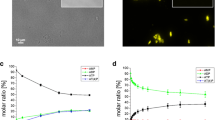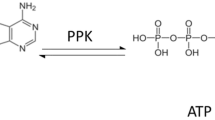Abstract
NAD kinase is a crucial enzyme for production of NADP+. Myxococcus xanthus is a gram-negative soil bacterium that forms fruiting bodies and spores under starvation, and it accumulates polyphosphate (poly(P)) during early development. We found that M. xanthus NAD kinase (PanK) utilized both ATP and poly(P) as phosphoryl donors; therefore, PanK was designated as a poly(P)/ATP-NAD kinase. Unlike other poly(P)/ATP-NAD kinases, PanK hardly exhibited NADH kinase activity. The NAD kinase activity of PanK was inhibited by NADPH, but not NADH. Replacement of Thr-90 in the GGDGT motif of PanK with Asn decreased both ATP- and poly(P)-dependent NAD kinase activities; however, poly(P)-dependent NAD kinase activity was further decreased by approximately 6- to 10-fold compared with ATP-dependent NAD kinase activity, suggesting that Thr-90 in the GGDGT motif of PanK may be important for poly(P) utilization. PanK preferred ATP and short-chain poly(P) as phosphoryl donors. The Km of PanK for ATP, poly(P)4, and poly(P)10–15 was 0.66 mM, 0.08 mM, and 0.71 mM, respectively, and the catalytic efficiency (kcat/Km) for poly(P)4 was 2.4-fold higher than that for ATP, suggesting that M. xanthus under starvation conditions may be able to efficiently generate NADP+ using PanK, ATP, and poly(P).


Similar content being viewed by others
References
Kawai S, Mori S, Mukai T, Hashimoto W, Murata K (2001) Molecular characterization of Escherichia coli NAD kinase. Eur J Biochem 268:4359–4365
Kawai S, Mori S, Mukai T, Suzuki S, Yamada T, Hashimoto W, Murata K (2000) Inorganic polyphosphate/ATP-NAD kinase of Micrococcus flavus and Mycobacterium tuberculosis H37Rv. Biochem Biophys Res Commun 276:57–63
Kornberg A (1995) Inorganic polyphosphate: toward making a forgotten polymer unforgettable. J Bacteriol 177:491–496
Rao NN, Gómez-García MR, Kornberg A (2009) Inorganic polyphosphate: essential for growth and survival. Annu Rev Biochem 78:605–647
Kornberg A (1999) Inorganic polyphosphate: a molecule of many functions. Prog Mol Subcell Biol 23:1–18
Grose JH, Joss L, Velick SF, Roth JR (2006) Evidence that feedback inhibition of NAD kinase controls responses to oxidative stress. Proc Natl Acad Sci USA 103:7601–7606
Ochiai A, Mori S, Kawai S, Murata K (2004) Overexpression, purification, and characterization of ATP-NAD kinase of Sphingomonas sp. A1. Protein Expr Purif 36:124–130
Butler JR, McGuinness ET (1982) Candida utilis NAD+ kinase: purification, properties and affinity gel studies. Int J Biochem 14:839–844
Tseng YM, Harris BG, Jacobson MK (1979) Isolation and characterization of yeast nicotinamide adenine dinucleotide kinase. Biochim Biophys Acta 568:205–214
Kawai S, Fukuda C, Mukai T, Murata K (2005) MJ0917 in archaeon Methanococcus jannaschii is a novel NADP phosphatase/NAD kinase. J Biol Chem 280:39200–39207
Sakuraba H, Kawakami R, Ohshima T (2005) First archaeal inorganic polyphosphate/ATP-dependent NAD kinase, from hyperthermophilic archaeon Pyrococcus horikoshii: cloning, expression, and characterization. Appl Environ Microbiol 71:4352–4358
Garavaglia S, Galizzi A, Rizzi M (2003) Allosteric regulation of Bacillus subtilis NAD kinase by quinolinic acid. J Bacteriol 185:4844–4850
Kawai S, Mori S, Mukai T, Matsukawa H, Matuo Y, Murata K (2001) Establishment of a mass-production system for NADP using bacterial inorganic polyphosphate/ATP-NAD kinase. J Biosci Bioeng 92:447–452
Whitworth DE (2008) Myxobacteria: multicellularity and differentiation. ASM Press, Washington, DC
Lee BU, Lee K, Mendez J, Shimkets LJ (1995) A tactile sensory system of Myxococcus xanthus involves an extracellular NAD(P)+-containing protein. Genes Dev 9:2964–2973
Kamatani S, Takegawa K, Kimura Y (2018) Catalytic activity profile of polyphosphate kinase 1 from Myxococcus xanthus. Curr Microbiol 75:379–385
Zhang H, Rao NN, Shiba T, Kornberg A (2005) Inorganic polyphosphate in the social life of Myxococcus xanthus: motility, development, and predation. Proc Natl Acad Sci USA 102:13416–13420
Kimura Y, Yamamoto H, Kamatani S (2019) Enzymatic characteristics of two adenylate kinases, AdkA and AdkB, from Myxococcus xanthus. J Biochem 165:379–385
Oka M, Takegawa K, Kimura Y (2015) Enzymatic characterization of a class II lysyl-tRNA synthetase, LysS, from Myxococcus xanthus. Arch Biochem Biophys 579:33–39
Nakamichi Y, Yoshioka A, Kawai S, Murata K (2013) Conferring the ability to utilize inorganic polyphosphate on ATP-specific NAD kinase. Sci Rep https://doi.org/10.1038/srep02632
Liu J, Lou Y, Yokota H, Adams PD, Kim R, Kim S-H (2005) Crystal Structures of an NAD Kinase from Archaeoglobus fulgidus in Complex with ATP, NAD, or NADP. J Mol Biol 354:289–303
Kawai S, Murata K (2008) Structure and function of NAD kinase and NADP phosphatase: key enzymes that regulate the intracellular balance of NAD(H) and NADP(H). Biosci Biotechnol Biochem 72:919–930
Mori S, Kawai S, Shi F, Mikami B, Murata K (2005) Molecular conversion of NAD kinase to NADH kinase through single amino acid residue substitution. J Biol Chem 280:24104–24112
Lundquist R, Olivera BM (1971) Pyridine nucleotide metabolism in Escherichia coli I. Exponential growth. J Biol Chem 246:1107–1116
Acknowledgments
This study was supported by Grants-in-Aid for Scientific Research from Japan Society for the Promotion of Science (JP16K07667).
Author information
Authors and Affiliations
Corresponding author
Ethics declarations
Conflict of interest
The authors declare no conflicts of interest associated with this manuscript.
Additional information
Publisher's Note
Springer Nature remains neutral with regard to jurisdictional claims in published maps and institutional affiliations.
Electronic supplementary material
Below is the link to the electronic supplementary material.
Rights and permissions
About this article
Cite this article
Kimura, Y., Kamimoto, T. & Tanaka, N. Enzymatic Characteristics of a Polyphosphate/ATP-NAD Kinase, PanK, from Myxococcus xanthus. Curr Microbiol 77, 173–178 (2020). https://doi.org/10.1007/s00284-019-01810-9
Received:
Accepted:
Published:
Issue Date:
DOI: https://doi.org/10.1007/s00284-019-01810-9




